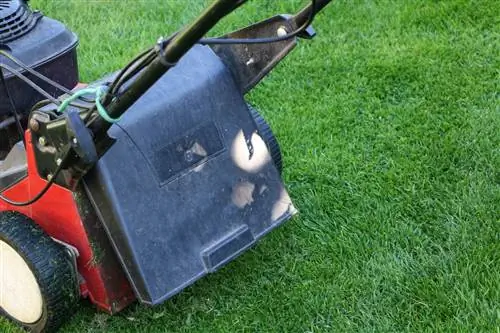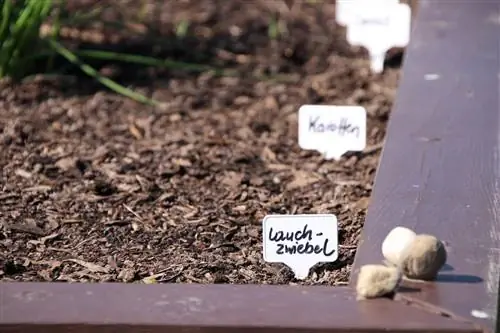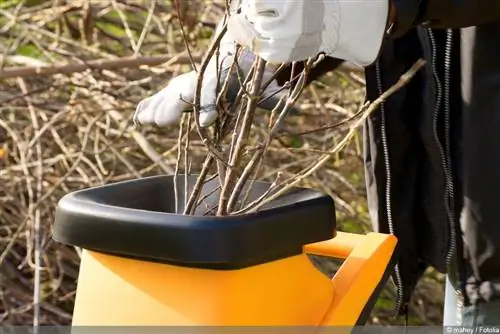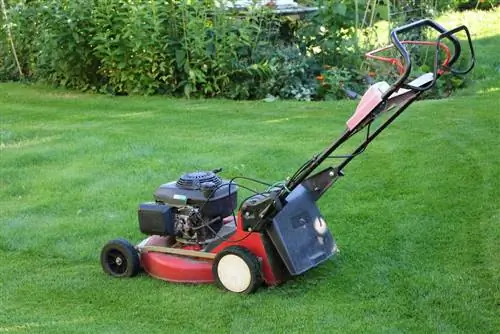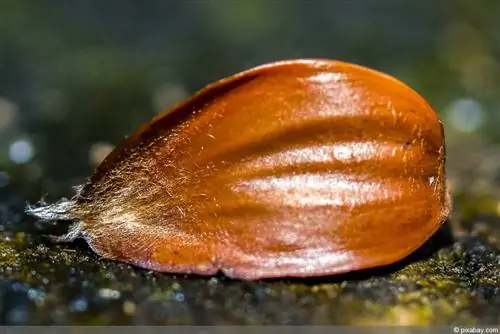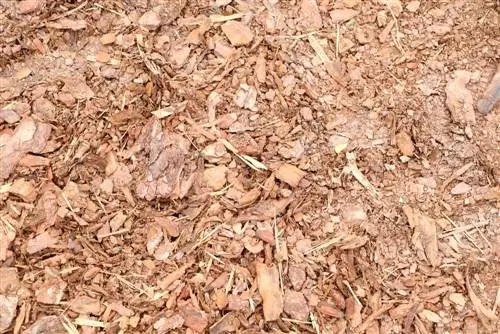- Author admin [email protected].
- Public 2023-12-17 03:39.
- Last modified 2025-01-24 12:45.
Lawn care includes regular mowing. A large amount of lawn clippings are produced between spring and autumn. One possible use for lawn waste is to use it as mulch.
Suitable lawn cuttings
At first glance, all lawn waste that comes from mowing looks the same. However, if it is to be used for mulching, it is worth taking a closer look. Grass clippings that contain seed-bearing grasses and/or weeds are not suitable as mulch. Because the seeds germinate after being planted and have to be weeded again later.
Tip:
Since short blades of grass decompose more easily than long blades, you should choose a fine cut when mowing.
Advantages
The benefits of using lawn waste as mulch are:
- protects the soil from drying out and wind erosion
- largely suppresses the growth of weeds
- rotts into valuable humus
- forms protection for the microorganisms living in the soil
- prevents crusting of the earth's surface
- is part of the natural cycle
Areas in the garden
You can use the cut blades of grass as mulch in all areas of the garden, such as
- in the vegetable patch, especially heavy-feeding vegetables
- under the trees
- under bushes
- under hedges
You should be careful with mulching in a perennial bed. Densely planted beds do not need mulch because the plants spread out and cover the soil surface. Spreading lawn waste on perennial beds that prefer dry soil is equally counterproductive.

Note:
Lawn waste is not suitable as mulch for clayey soils, as the risk of waterlogging increases.
Time
Grass clippings can be used for mulching from spring to fall. The lawn waste from the first mowing passes is particularly suitable for the vegetable patch. However, you should only spread the material when the vegetable plants have reached a height of at least ten centimeters.
Instructions in seven steps
Follow these steps and enjoy the fruits of your labor.
Let it dry
Whether the grass clippings can be used for mulching directly from the lawn mower's collection container or should be allowed to dry slightly first is controversial. The disadvantage of drying is that the material does not dry as compactly and is therefore blown away by the wind. With freshly cut material, there is a risk that it will start to rot because it sticks together. The green also attracts snails.
Tip:
To dry, you can simply leave the cut grass blades lying on the mowed area.
Removing weeds
It's true that lawn clippings are good protection against weeds. However, it only protects against new wild plants. Therefore, you should weed the bed before applying the mulch layer.
Long-term fertilizer
The rotting process of lawn waste removes nitrogen from the soil. However, since this is essential for the growth of vegetable plants, some professional gardeners recommend applying a biological long-term fertilizer to the bed before mulching.
Thickness of the mulch layer
The height at which you apply the mulch layer depends on whether the material is fresh or slightly dried:
- fresh grass cuttings: about eight to ten centimeters, quickly collapses in half as they dry
- slightly dried grass clippings: about four to five centimeters
If the weather is rather humid when mowing or in the next few days, you should spread fresh lawn clippings at a maximum height of two centimeters, as lawn clippings in which moisture accumulates easily begin to rot. In addition, it sticks together strongly so that no oxygen penetrates to the ground.
Distance for vegetable plants
Since there is a risk that the mulch layer will begin to rot, especially in wet weather, you should not mulch two to three centimeters around the plant with lawn waste.

Loosen up
Although most grass clippings will rot after a few weeks, the rotting process can take longer in unfavorable weather. That's why you should always slightly loosen the mulch layer. This way you can also avoid
- a mulch layer that is a little too thick becomes compacted or
- Mice discover the grass clippings as a roost.
Reapplying
When you can mulch again with the lawn waste depends on the rotting process. The prerequisite for applying a new layer of mulch is that the old one has decomposed. This is usually the case after four to six weeks.
Special blends
If additional material is added to the lawn clippings, you can create special mixtures for individual areas in the garden. In addition, the risk of the lawn waste starting to rot is reduced.
- Vegetable bed: mix cut grass with shredded vegetable waste (leaves, peels) and some coarse compost
- fruit-bearing shrubs: mix lawn waste with finely chopped hedge trimmings from spring pruning and a little bark mulch
- Strawberry bed: Mix grass clippings with a little straw, apply shortly before harvest, strawberries stay dry
- Winter protection for the soil: Mix lawn clippings with other shredded clippings and plant residues, spread thickly

